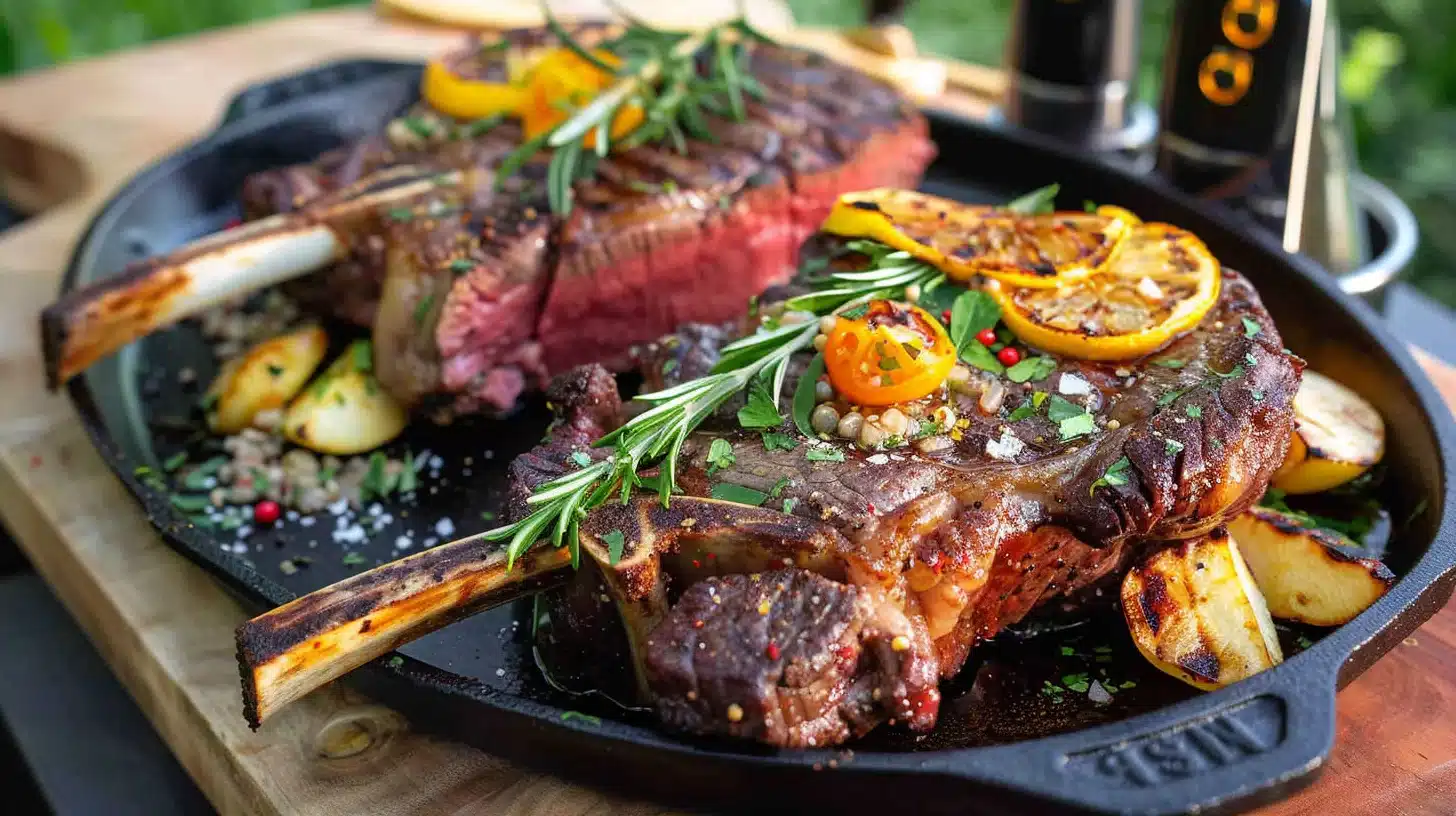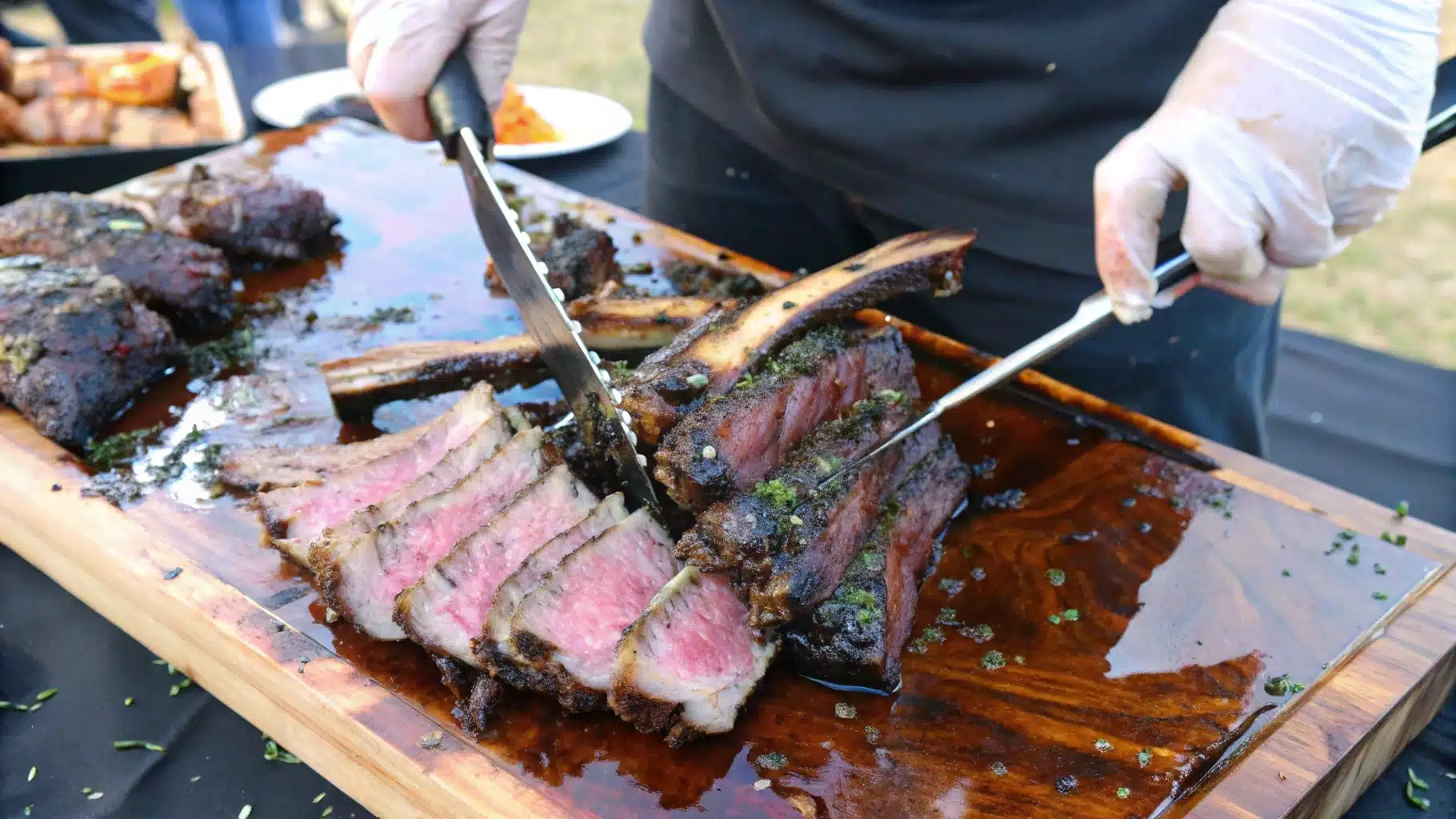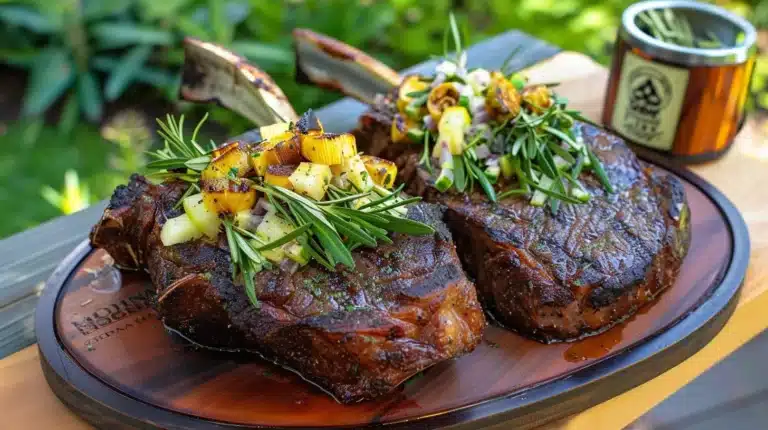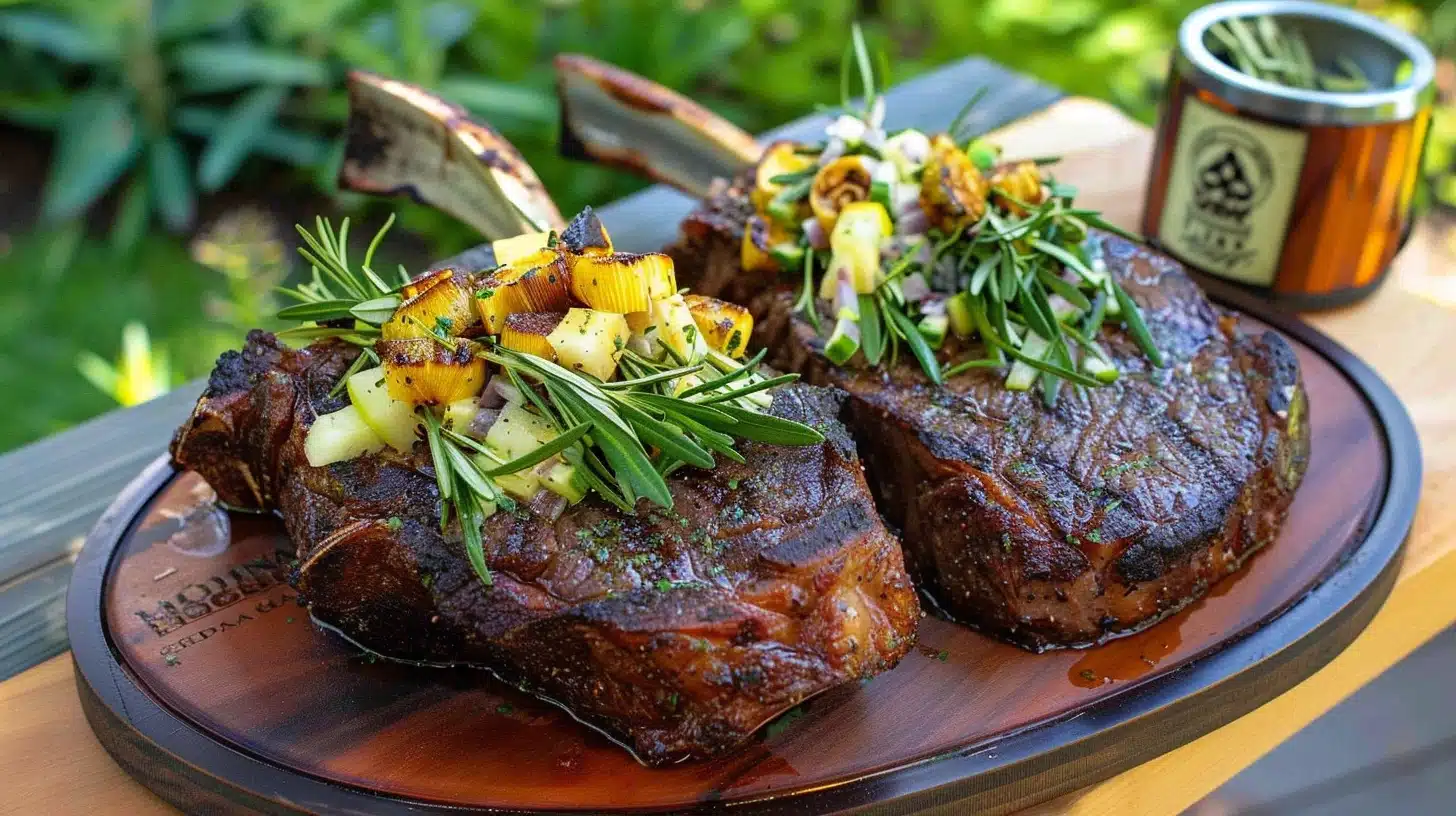I still remember the first time I savored a tomahawk steak; it was at a high-end restaurant, and the experience was nothing short of exceptional. The tenderness and rich flavor of the steak left a lasting impression on me. This luxurious cut of meat, known for its steakhouse quality, has become a favorite among steak enthusiasts.
The tomahawk steak is more than just a meal; it’s an experience. With its tender texture and rich flavor, it’s a delight for anyone looking to elevate their dining experience. In this article, we will explore the characteristics, benefits, and cooking methods of this luxurious cut of meat.
Love juicy steak recipes? Try my Cowboy steak, Spencer Steak, 12 oz steak, and Tender Korean beef short ribs
next.
Key Takeaways
- The tomahawk steak is known for its rich flavor and tender texture.
- It’s a luxurious cut of meat, ideal for special occasions or fine dining.
- Proper cooking methods can enhance its natural flavors and texture.
What Is a Tomahawk Steak?
A Tomahawk Steak is a ribeye steak with a distinctive twist, characterized by its long, intact bone, which not only adds to its visual appeal but also enhances its rich, beefy flavor. This cut of meat is taken from the rib section of the cow, typically between the 6th and 12th ribs. The Tomahawk Steak’s unique appearance, coupled with its tender and flavorful characteristics, makes it a prized choice among steak connoisseurs.
The Anatomy of a Tomahawk Cut
The anatomy of a Tomahawk Steak includes a generous portion of marbling, which is the intermingling of fat within the meat. This marbling is crucial as it contributes significantly to the steak’s tenderness and flavor profile. The long bone, typically left intact, is a hallmark of this cut, making it not only a feast for the palate but also a visually stunning centerpiece for any dining occasion.
Origin and Naming
The Tomahawk Steak gets its name from its resemblance to a tomahawk axe, due to the long bone being left intact. This cut originated from the rib section of the cow, and its naming is largely attributed to its unique appearance. The Tomahawk Steak has become a sought-after dish in high-end restaurants, where its presentation and flavor profile are highly valued.
The Appeal of Tomahawk Steak
With its impressive presentation and succulent taste, the tomahawk steak is a favorite among meat connoisseurs. This premium cut of beef has gained popularity not only for its rich flavor but also for its visual appeal, making it a centerpiece for any dining experience.
Exceptional Marbling and Flavor Profile
The tomahawk steak is renowned for its exceptional marbling, which is the intramuscular fat that disperses throughout the meat. This marbling enhances the flavor profile, making the steak more tender and juicy. The generous fat distribution ensures that each bite is filled with a rich, beefy flavor that is characteristic of a high-quality steak.
Marbling’s Role in Flavor Enhancement
- Contributes to the tenderness of the steak
- Enhances the juiciness and succulence
- Adds depth and complexity to the flavor
Visual Impact and Presentation Value
The tomahawk steak’s impressive size and the long bone it is cut with make it a visually stunning dish. When presented correctly, it can be a showstopper at any dinner gathering, adding an element of luxury and sophistication to the meal.

Texture and Tenderness
The texture and tenderness of a tomahawk steak are significantly influenced by its marbling and the aging process it undergoes. Proper aging can enhance the tenderness, making the steak melt-in-your-mouth tender.
| Characteristics | Tomahawk Steak | Ribeye |
| Marbling | Extensive | Moderate |
| Tenderness | Very Tender | Tender |
| Presentation | Impressive | Standard |
Why Are Tomahawk Steaks So Expensive?
Understanding the expense associated with tomahawk steaks requires examining the intricacies of their production and presentation. The unique characteristics and high-quality standards of tomahawk steaks justify their premium pricing.
Specialized Butchering Process
The process of creating a tomahawk steak is labor-intensive and requires skilled butchers. The long, French trimming process involved in preparing the steak is time-consuming and results in significant waste, contributing to the higher cost. This meticulous process ensures the steak’s signature appearance and quality.
Premium Meat Yield Considerations
Tomahawk steaks are cut from the rib section, known for its rich marbling, which enhances flavor and tenderness. The quality of the meat and the yield from the carcass directly impact the pricing, with higher quality and lower yield resulting in higher prices. The marbling and tenderness are key factors that justify the premium pricing of tomahawk steaks.
Restaurant Markup and Prestige Factor
Restaurants often apply a significant markup to tomahawk steaks due to their prestige and the dining experience they offer. The presentation and service associated with serving such a high-end cut contribute to its final cost. The exclusivity and luxury associated with tomahawk steaks make them a premium offering in fine dining establishments.
| Factor | Description | Impact on Price |
| Specialized Butchering | Labor-intensive process | High |
| Premium Meat Yield | Quality and quantity of meat | High |
| Restaurant Markup | Prestige and dining experience | Significant |

Tomahawk vs. Ribeye: What’s the Difference?
When it comes to choosing between a Tomahawk and a Ribeye steak, several factors come into play. While both cuts are known for their rich flavor and tender texture, there are distinct differences between them.
Structural Comparison
The primary difference between Tomahawk and Ribeye steaks lies in their bone structure. Tomahawk steaks are characterized by a long bone, typically frenched, which gives them a distinctive appearance. In contrast, Ribeye steaks usually have a shorter bone or are sometimes boneless. This difference in presentation can significantly impact the overall dining experience.
| Characteristics | Tomahawk Steak | Ribeye Steak |
| Bone Structure | Long bone, typically frenched | Shorter bone or boneless |
| Presentation | Distinctive, visually appealing | More traditional, less showy |
Flavor and Cooking Differences
While both Tomahawk and Ribeye steaks are renowned for their rich flavor profile, the cooking methods can slightly differ due to their structural differences. Tomahawk steaks, with their larger size and bone structure, may require adjusted cooking techniques to achieve the perfect doneness. Ribeye steaks, being generally smaller and more straightforward to cook, offer more flexibility in cooking methods.
Cooking a Tomahawk steak often involves techniques like reverse searing, which helps to achieve a tender and evenly cooked steak. On the other hand, Ribeye steaks can be cooked using a variety of methods, including grilling, pan-searing, or oven roasting.

Value and Price Considerations
The value and price of Tomahawk and Ribeye steaks can vary significantly, influenced by factors such as the butchering process, meat yield, and restaurant markup. Tomahawk steaks, due to their specialized cutting and presentation, tend to be more expensive. Ribeye steaks, while still a premium product, can be more affordable depending on the quality and source.
When deciding between Tomahawk and Ribeye steaks, consumers should consider their personal preferences, cooking capabilities, and budget. Whether the premium presentation of a Tomahawk steak is worth the extra cost is a matter of individual taste and dining experience.
Buying the Perfect Tomahawk Steak
When it comes to purchasing a tomahawk steak, several factors come into play to ensure you get the perfect cut. To make an informed decision, it’s essential to understand what characteristics to look for in a high-quality tomahawk steak.
What to Look For
When selecting a tomahawk steak, look for cuts with generous marbling, as this indicates tenderness and flavor. The steak should have a bright red color, and the fat should be evenly distributed. A thick cut, typically around 2 inches, is ideal for achieving the perfect doneness.
Where to Purchase Quality Cuts
You can find quality tomahawk steaks at reputable butchers or high-end grocery stores. Specialty meat markets and some online retailers also offer premium tomahawk steaks. When purchasing, ensure that the steak is handled and stored properly to maintain its quality.
Storage and Preparation Before Cooking
Proper storage and preparation are crucial to maintaining the quality of your tomahawk steak. Store it in the refrigerator at a consistent temperature below 40°F (4°C). Before cooking, pat the steak dry with paper towels to remove excess moisture, and season it according to your recipe.
| Storage Tips | Preparation Tips |
| Store in refrigerator below 40°F (4°C) | Pat dry with paper towels |
| Keep away from strong-smelling foods | Season according to your recipe |
Best Ways to Cook Tomahawk Steak
Mastering the cook on a Tomahawk steak involves understanding different cooking approaches. The key to a perfectly cooked Tomahawk lies in the technique, whether you’re grilling, using the reverse sear method, or cooking it in the oven before finishing it in a pan.
Grilling Method
Grilling is a popular method for cooking Tomahawk steaks as it adds a smoky flavor and a nice char on the outside. To grill a Tomahawk steak effectively, you need to understand the difference between direct and indirect heat techniques.
Direct vs. Indirect Heat Techniques
Direct heat involves placing the steak directly over the flames, which is ideal for achieving a nice sear. On the other hand, indirect heat means cooking the steak away from the direct flames, which helps in cooking the steak evenly without burning the outside.
Temperature Management
Managing the temperature is crucial when grilling a Tomahawk steak. Preheat your grill to high heat for searing, then adjust as necessary to maintain a consistent temperature for even cooking.
Reverse Sear Technique
The reverse sear technique is a two-step process that involves cooking the steak in a low-temperature environment first, followed by a high-heat sear. This method ensures a perfectly cooked interior and a crispy crust.
Low-and-Slow Phase
Start by cooking the Tomahawk steak in a low-temperature oven until it reaches your desired level of doneness. This slow cooking process helps in achieving a uniform internal temperature.
Final Searing Phase
Once the steak is cooked to your liking, finish it off with a high-heat sear in a hot pan or on the grill. This step adds the crust that makes a Tomahawk steak irresistible.
Oven-to-Pan Method
The oven-to-pan method is another effective way to cook a Tomahawk steak. It involves cooking the steak in the oven first and then finishing it in a pan.
Oven Temperature and Timing
Cook the steak in a preheated oven at a low temperature until it is about 10-15°F away from your desired internal temperature. Use a meat thermometer to monitor the temperature.
Cast Iron Finishing
Finish the steak by searing it in a hot cast-iron pan. This adds a flavorful crust to the steak. Make sure the pan is hot before adding the steak to achieve a good sear.
| Cooking Method | Temperature Control | Finishing Technique |
| Grilling | High heat for searing, adjusted for even cooking | Direct searing on grill |
| Reverse Sear | Low temperature for slow cooking, high heat for searing | Searing in pan or on grill |
| Oven-to-Pan | Low oven temperature, high heat for pan searing | Searing in cast-iron pan |
Step-by-Step Tomahawk Steak Recipe
Elevate your steak game with this easy-to-follow tomahawk steak recipe that yields impressive results. Cooking a tomahawk steak can seem intimidating, but breaking it down into manageable steps makes all the difference.
Preparation and Seasoning
To start, bring your tomahawk steak to room temperature by letting it sit for about 30 minutes to an hour before cooking. This step is crucial for even cooking. Next, season the steak generously with your preferred seasonings. A simple mix of salt, pepper, and garlic powder works wonders, but feel free to get creative with your favorite herbs and spices.
- Pat the steak dry with paper towels to remove excess moisture.
- Rub the steak with a drizzle of olive oil to help the seasonings stick.
- Sprinkle your chosen seasonings evenly over both sides of the steak.
Reverse Sear Cooking Instructions
The reverse sear method is a game-changer for cooking tomahawk steaks. It involves cooking the steak in a low-temperature oven first, followed by a high-heat sear. This approach ensures a perfectly cooked interior and a crispy crust.
Low Temperature Cooking Phase
Preheat your oven to 200°F (90°C). Place the steak on a wire rack over a rimmed baking sheet to allow air to circulate around the steak. Cook the steak in the oven until it reaches your desired level of doneness. For medium-rare, this is typically around 55-60°C (130-140°F) internal temperature.
Use a meat thermometer to check the internal temperature accurately.
High Heat Searing Phase
Once the steak is cooked to your liking, it’s time to sear it. Heat a skillet or grill pan over high heat with a small amount of oil until it smokes. Sear the steak for 1-2 minutes per side, depending on the thickness and your desired level of crust. You can also add aromatics like garlic and thyme to the pan for extra flavor.
Resting and Serving
After searing, remove the steak from the heat and let it rest on a plate for 5-10 minutes. This allows the juices to redistribute, making the steak even more tender and flavorful. Slice the steak against the grain and serve immediately.
By following these steps, you’ll be able to achieve a perfectly cooked tomahawk steak that’s sure to impress. Enjoy the process and the delicious results!
Tips for Perfectly Cooked Tomahawk Steak
With the right approach, anyone can cook a Tomahawk steak that rivals those served in top steakhouses. Achieving perfection requires attention to detail and a few key techniques.
Temperature Guidelines for Different Doneness Levels
Cooking a Tomahawk steak to the right temperature is crucial. For rare, aim for an internal temperature of 120°F – 130°F, medium rare is 130°F – 135°F, and medium is 140°F – 145°F. Use a thermometer to ensure accuracy.
It’s also important to consider the temperature rise during resting. For instance, a steak cooked to 130°F will rise to about 135°F after resting.
Common Mistakes to Avoid
One of the most common mistakes when cooking a Tomahawk steak is overcooking it. Tomahawk steaks are best enjoyed at medium rare or rare. Another mistake is not letting the steak rest long enough, which can result in lost juices.
- Not using a thermometer
- Overcooking the steak
- Not letting the steak rest
Essential Tools and Equipment
To cook a Tomahawk steak perfectly, you’ll need a few essential tools. A cast-iron skillet or a grill is ideal for searing, while a meat thermometer ensures you’ve reached the correct internal temperature.
By following these guidelines and avoiding common pitfalls, you’ll be well on your way to cooking a Tomahawk steak that’s sure to impress.
FAQ
What meat is a tomahawk steak?
A tomahawk steak is a cut of beef, specifically a ribeye steak with a long bone left intact, taken from the rib section.
Why is tomahawk steak so expensive?
Tomahawk steaks are considered expensive due to the specialized butchering process, premium meat yield, and the prestige associated with serving such a high-end cut.
Is tomahawk better than ribeye?
Tomahawk and ribeye steaks are essentially the same cut of meat, with the primary difference being the presence of a long bone in tomahawk steaks. The choice between the two often comes down to personal preference and presentation.
What is the best way to cook tomahawk steak?
The best ways to cook a tomahawk steak include grilling, the reverse sear technique, and the oven-to-pan method, all of which can produce a tender and flavorful steak when done correctly.
How do I cook a tomahawk steak on the grill?
To grill a tomahawk steak, you can use direct or indirect heat techniques, with careful temperature management to achieve the desired level of doneness.
What is the reverse sear method for cooking tomahawk steak?
The reverse sear method involves cooking the steak at a low temperature first, followed by a high-heat searing phase, resulting in a perfectly cooked steak with a crispy crust.
How do I achieve the perfect doneness when cooking a tomahawk steak?
To achieve the perfect doneness, it’s essential to follow temperature guidelines for different doneness levels and use a thermometer to ensure accuracy.
Conclusion
The tomahawk steak is a luxurious cut of meat that offers a unique dining experience, rich in flavor and tender in texture. By understanding its characteristics, cooking methods, and premium pricing, you can appreciate the value of this exceptional steak. Whether you’re a seasoned steak enthusiast or looking to try something new, the tomahawk steak is sure to impress.
Cooking a tomahawk steak to perfection requires attention to detail and the right techniques. From grilling to reverse searing, the methods outlined in previous sections provide a solid foundation for achieving a deliciously cooked steak. By following these guidelines and avoiding common mistakes, you can ensure a memorable dining experience.
In summary, the tomahawk steak is a show-stopping centerpiece for any special occasion or fine dining experience. Its rich flavor profile, tender texture, and visually appealing presentation make it a standout choice among steak connoisseurs. As you explore the world of premium steaks, the tomahawk steak is definitely worth considering for its unique characteristics and exceptional taste.
Looking for more delicious recipes? Check out these amazing collections:
➡Get inspiration from Pinterest to find other delicious dishes to serve with your meal.
➡ Keep an eye on Hyper Recipes’ Facebook for the latest recipes, cooking tips, and meal suggestions.
Related Recipes You Might Love
Want to explore more side dishes? Check out these delicious recipes:
- cowboy butter for steak –A creamy and delicious classic that goes well with every meal.
- Tender Korean beef ribs: Juicy, flavorful short ribs marinated in a savory-sweet Korean sauce, then slow-cooked or grilled until fall-off-the-bone tender.
- Beef Bourguignon – A classic French stew made with tender beef, red wine, mushrooms, and herbs, slow-cooked to rich, hearty perfection.
- Italian Beef – A Chicago Classic Packed with Bold, Savory Flavor
- Cowboy cut steak – A hearty and satisfying meal with a rustic touch.
For more homemade meal ideas, visit Hyper Recipe and explore a variety of delicious dishes!
Print
How to Make the Best Juicy Tomahawk Steak with Charred Veggies
The Tomahawk Steak is the ultimate show-stopper — a thick, bone-in ribeye with a dramatic presentation and bold, beefy flavor. Perfect for special occasions or backyard grilling, this steak is known for its rich marbling, tenderness, and visual impact. Seasoned simply and cooked to perfection, it delivers a restaurant-quality experience right at home.
- Total Time: 45 minutes
- Yield: 1 Tomahawk steak
Ingredients
1 Tomahawk ribeye steak (2–3 lbs, 2 inches thick)
2 tablespoons olive oil
1 tablespoon kosher salt
1 tablespoon freshly ground black pepper
1 teaspoon garlic powder
2–3 sprigs fresh rosemary (optional)
3 tablespoons unsalted butter (for basting)
4 cloves garlic, smashed (for basting)
Instructions
Bring to Room Temperature: Remove the steak from the fridge 1 hour before cooking to bring it to room temperature.
Preheat Grill or Oven: Preheat your grill to medium-high heat or your oven to 250°F (if using reverse sear method).
Season Generously: Pat the steak dry. Rub with olive oil, then season all sides with salt, pepper, and garlic powder.
Sear the Steak:
Grill method: Sear the steak directly over high heat for 3–4 minutes per side to develop a crust.
Pan method: Sear in a cast iron skillet over high heat for 3–4 minutes per side.
Finish Cooking:
Grill method: Move steak to indirect heat and cook until internal temperature reaches 125°F (for medium-rare).
Oven method (reverse sear): Cook at 250°F until internal temp is 110°F, then sear in a hot skillet for a crust.
Butter Baste (Optional): In the last minute of searing, add butter, smashed garlic, and rosemary to the pan and spoon the melted butter over the steak.
Rest: Let the steak rest for 10 minutes, tented with foil, before slicing.
Slice & Serve: Slice against the grain and serve with your favorite sides.
Notes
Use a meat thermometer for accuracy—125°F for medium-rare, 135°F for medium.
Letting the steak rest ensures juiciness and flavor.
Pairs well with roasted potatoes, grilled vegetables, or a chimichurri sauce.
- Prep Time: 10 minutes
- Cook Time: 35 minutes
- Category: Main Course
- Method: Grilling
- Cuisine: American
Nutrition
- Serving Size: 1/3 steak
- Calories: 850
- Sugar: 0g
- Sodium: 90mg
- Fat: 60g
- Saturated Fat: 25g
- Unsaturated Fat: 30g
- Trans Fat: 1g
- Carbohydrates: 1g
- Fiber: 0g
- Protein: 70g
- Cholesterol: 190mg
Keywords: tomahawk steak, grilled tomahawk steak, reverse sear steak, bone-in ribeye, steak recipe, special occasion steak






